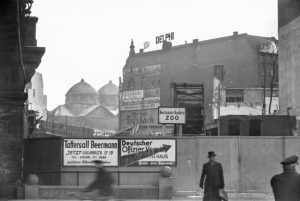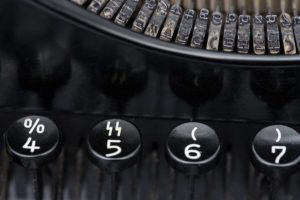A new fascinating exhibition at Berlin’s Märkisches Museum shows the “normality” of everyday life in the German capital under Nazi rule. Society has been transformed, the dictatorship already permeates all aspects of life, there is no escape from the consequences of the regime’s incessant propaganda. How did the 140 000 Jews in Berlin fare under the ever-more prevalent anti-Semitism?

View of the synagogue in the Fasanenstraße, captured by photo journalist Harry Croner in 1937
Stadtmuseum Berlin
In a pharmacy toothpaste with a swastika. A mood of fear such as must have existed in France under the Jacobins,” noted Victor Klemperer in March 1933. “No one fears for their lives yet – but for bread and freedom.” The diaries of the scholar provide an exceptional account of day-to-day life in Nazi Germany. Some weeks before, in a radio speech on February 10, Hitler had pledged to turn the economy around: “People of Germany, give us four years and then pass judgment upon us!”
“Give me four years’ time” – with this slogan, the newly appointed chancellor had promised a total transformation of German society. In the spring of 1937, an exhibition in Berlin showcased recent achievements of the regime, for example increasing employment and rearmament. By that time, the National Socialist dictatorship had permeated all aspects of German everyday life. The previous year had been shaped by the Wehrmacht’s invasion of the demilitarized Rhineland and by the Olympic Games. Soon to follow were the “Anschluss” of Austria, the Sudeten crisis, and the November pogroms of 1938.
1937, however, was characterized by a false sense of calm in Germany – including Berlin. What was the city like for its residents as they went from their homes to school or to work, to church or to synagogue, to air raid exercises or to a dance? What changed under Nazi rule, what remained the same? What were the consequences for individuals and for societal groups? And: To what degree was it possible to recognize the system’s criminal nature before the war and the Holocaust began?
In its special exhibition “In the Shadow of Things to Come“ (“Im Schatten von morgen”), Berlin’s Märkisches Museum, which explores the history of Berlin from its origins to this day, presents a collection of unique, never-before displayed original objects, historical photos, documents, sound recordings, and film excerpts which bear witness to the deceptive normality under the Nazi regime. The exhibition takes a multi-media approach to give deep insights into life in the city at the time from a wide range of perspectives.
Censorship and conformity
Diplomats, businessmen, and artists from all over the world were stationed in Berlin, providing a broad international view. However, even foreign correspondents were not free to report as they saw fit. “I myself was to experience how easily one is taken in by a lying and censored press and radio in a totalitarian state,” remembered American journalist William L. Shire, who became known for his broadcasts from Berlin. “No one who has not lived for years in a totalitarian land can possibly conceive how difficult it is to escape the dread consequences of a regime’s calculated and incessant propaganda.” In 1937, Berlin was still Germany’s newspaper capital. Newspaper bans and closures, as well as the lack of critical reporting due to political pressure, had substantial impact on the press, which was forced into compliancy and conformity. Most foreign correspondents had realized how bad things could get, though there were infamous exceptions: In February 1937, National Geographic published “Changing Berlin.” In his 47-page feature story, a loving paean to a regime considered as efficient and benign, Douglas Chandler painted a happy portrait of Berlin. By that time, the Nazi regime had completed a period of power consolidation and was yet to begin preparing for war – it was a phase of relative calm for Germany, both domestically and in international relations. This comparatively uneventful time is the focus of the exhibition’s analytical depiction of everyday life in the city. The show has been conceived as a walk-around tour that encompasses views of the urban landscape, representations of everyday life, special displays, places of fear, and historical themes on a wide range of subjects.

Detail of typewriter “Olympia”, Europa Schreibmaschinen AG Berlin, after 1933
Stadtmuseum Berlin / Oliver Ziebe
In 1937, the Jewish Community of Berlin numbered about 140,000 members. The ever-more prevalent anti-Semitism awoke a growing desire for re-orientation. Many of Berlin’s Jews still believed a sense of solidarity would allow them to deal with isolation, loss, and humiliation, and that a return to religious values would help to foster a sense of identity and community. Force and deceit were used to drive German Jews out of professional and economic life. Self-employed, middle-class Jews, particularly doctors and lawyers, found their livelihood threatened, and more and more Jewish families had to take advantage of the offerings of Jewish relief agencies to fight social decline. In an increasingly hostile environment, Jewish schools provided one of the last refuges for children and young people, who had very little chance of entering skilled professions after completing school. The Reich Federation of Jewish Cultural Association, which had been founded in 1935, in July 1937 was comprised of 122 independent organizations throughout Germany and had to cope with emigration, poverty, and the state’s attempt of ghettoization. To foster Jewish pride, the Jewish Community marked the 500th birthday of Don Isaac Abravanel, a Jewish leader in fanatically Christian Spain, with a commemorative medal and a series of public events.
In August 1937, Berlin’s district of Prenzlauer Berg had the inscription “Für Juden verboten” (“Off limits for Jews”) painted on 92 of 100 park benches, and local authorities did not intervene but discussed the possibility of expanding the measure into a citywide regulation. It was not only the Reich institutions located in Berlin that contributed to making the German capital true to the Nazi line. Especially the local administrative apparatuses were a driving force of the dictatorship. Berlin’s government agencies supplemented the Nuremberg race laws with additional regulations that targeted the Jewish population and institutions, including day care centers, book shops, and housing. The approval level of Nazism was very high among Berlin police officers, who investigated and arrested regime dissidents, Jews, homosexuals, Sinti and Roma, as well as socially marginalized groups, and turned them over to the SS or the Gestapo.
“No people ever recognize their dictator in advance,” reflected US journalist Dorothy Thompson in 1935. The actual impact on society was often apparent only at second glance. Amateur photographs, passed down through family narratives, evoked and still evoke both empathetic identification and a critical distance. In the cultural sector, Nazi influence was apparent not so much in what the spectators were presented, as in what was not shown. The exhibition space itself is also an object of critical reflection. In 1937, the Märkisches Museum took part in Berlin’s 700-year anniversary celebrations, which were exploited by the Nazi regime. “It is time that we confront this era more intensively,” says Director Paul Spies. “This is especially important in times when facts, values, and political positions are changing and society is in the midst of a transformation.”
Im Schatten von Morgen runs at Märkisches Museum Berlin until 14 January 2018
https://www.stadtmuseum.de/ausstellungen/berlin-1937
